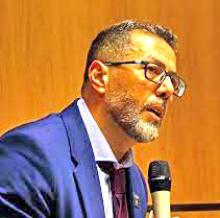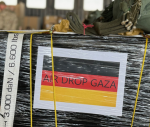You are here
The danger lurking beneath Al Aqsa
Mar 11,2014 - Last updated at Mar 11,2014
Something sinister is brewing around and below Al Aqsa Mosque in occupied East Jerusalem, and it has the hallmark of a familiar Israeli campaign to strip the mosque of its Muslim Arab identity. This time around, however, the stakes are much higher.
The status of Al Aqsa Mosque is unparallelled in the context of Muslim heritage in Palestine. It is also the third holiest Muslim shrine anywhere. But equally important, it is a symbol of faith, resistance and defiance.
Its story of struggle and perseverance goes hand in hand with the very modern Palestinian struggle for rights, freedom and identity. Praying at Al Aqsa at times seems like an impossible feat. Many Palestinians lost life or limbs simply trying to gain access to the mosque.
In a statement released on March 7, the Palestinian ministry of awqaf and religious affairs said Israeli forces carried out 30 attacks against Al Aqsa Mosque and other holy sites during the month of February alone.
Most of the attacks targeted Al Aqsa itself. While the recurring violations at Al Aqsa were led by Jewish settlers, according to the statement, they have done so under the watchful eye, protection and support of the Israeli police and army.
Most alarming about these attacks is their political context, which indicates that a great degree of coordination is under way among politicians, security forces and Jewish settlers.
In anticipation of a Palestinian backlash, on March 4, an Israeli court sentenced Islamic leader Sheikh Rade Saleh to eight months in prison for “incitement”.
The sheikh is the most outspoken Palestinian leader regarding the danger facing Al Aqsa. Why silence Saleh now, when the attacks against Al Aqsa are at an all times high?
It was on February 25, 1994, that US-born Jewish extremist Baruch Goldstein stormed the Ibrahimi Mosque in the Palestinian city of Hebron and opened fire. The aim was to kill as many Arabs as he could.
At that moment, nearly 800 Muslim worshipers were kneeling down during the dawn prayer in the holiest month of the Muslim calendar, Ramadan.
Goldstein killed 30 and wounded over 120. Exactly 20 years later, the Israeli army stormed Al Aqsa Mosque, the third holiest Muslim site, and opened fire. The timing was no accident.
Like the rest of the West Bank, Hebron is facing the dual challenge of armed Jewish settlers and Israeli occupation soldiers, the latter enforcing the military occupation, while providing further protection to the settlers.
The settlers, extremists from the illegal settlement of Kiryat Arba, often attack Palestinian residents of the town with complete impunity. Interestingly, many of Kiryat Arba settlers are Americans, as was Goldstein.
It was not enough that Israeli soldiers in the vicinity of the Ibrahimi Mosque allowed Goldstein — armed with a Galil rifle and other weapons — access to the mosque, they also opened fire on worshipers as they tried to flee the scene. Israeli soldiers killed 24 more and injured others.
Goldstein, now a hero in the eyes of many in Israel, is often blamed solely for the massacre in Hebron. But it was a common deed he and the Israeli army were responsible for.
This symbiotic relationship between the army and settlers, which dates back to the early days of the Israeli occupation of Jerusalem, the West Bank and Gaza in 1967, continues.
While Israeli bulldozers dig into Palestinian land during the day, levelling mounds of ground and destroying olive groves for settlement expansion, heavy machinery burrows beneath the Old City of Jerusalem at night.
The Israelis are looking for evidence of what they believe to be ancient Jewish temples, presumably destroyed in 586BC and AD70. To fulfil some “prophecy”, Jewish extremists believe that a third temple must be built.
But, of course, there is the inconvenient fact that on that particular spot exists one of Islam’s holiest sites: The Haram Al Sharif. It has been an exclusively Muslim prayer site for the last 1,300 years.
The Noble Sanctuary, located in Jerusalem’s Old City, is the home of Al Aqsa Mosque and the Dome of the Rock. The site has been under constant threat, attacks, acts of arson and military violence for nearly five decades.
The few Muslim clergy — belonging to the Islamic trust which manages the area, along with the custodianship of Jordan — are mindful of the ever-lurking Israeli threat that oftentimes turns deadly.
It was no surprise that Israeli leader Ariel Sharon chose that exact place to carry out his “tour” of Al Aqsa compound in 2000. Many unarmed Palestinians, mostly worshipers, died on that day.
Thousands more lost their lives in the following months and years as the Palestinian towns occupied by Israel exploded with unprecedented fury. Sharon was later elected prime minister of Israel.
That same dangerous combination — right-wing politicians allied with religious zealots — is at work once more.
They are eyeing Al Aqsa for annexation, the same way the Israeli government is labouring to permanently annex large swathes of the occupied West Bank, to preclude any future settlement with the Palestinian Authority of Mahmoud Abbas.
The Israeli Knesset chose the 20th anniversary of the Goldstein massacre of Palestinians in Hebron to begin a debate concerning the status of Al Aqsa compound.
Right-wingers — which constitute the bulk in the government of Prime Minister Benjamin Netanyahu — want the Israeli government to enforce its “sovereignty” over the Muslim site, which is administered by Jordan, as per the Jordanian-Israeli peace treaty of 1994.
Israeli member of Knesset Moshe Feiglin is the man behind the move, but he is not alone.
Feiglin is a member of Netanyahu’s Likud Party, and has strong backing within the party, the government and the Knesset.
A major backer of Feiglin’s initiative is Miri Regev, also a far-right Likud member. Regev is demanding that the government establish separate prayer times for both Jews and Muslims in Al Aqsa compound.
The model she wishes to duplicate is no other than the Ibrahimi Mosque.
“We will reach a situation where the Temple Mount will be like the Cave of the Patriarchs, days for Jews and days for Muslims,” she said.
On the day following the Israeli government debate, a thundering sound was heard around 3:00am in the Wadi Hilweh neighbourhood of Silwan, south of the Old City of Jerusalem.
Residents heard the “sounds of heavy-duty machines digging under their houses throughout the night”, Ma’an reported.
Then, a large wall suddenly collapsed, while a few houses sustained damage. The Israeli underground network of tunnels is growing, as some of these tunnels connect Wadi Hilweh to the Western Wall to Al Aqsa.
While the danger of Al Aqsa Mosque collapsing is very real, it is a representation of the mentality that rules Israel: one of annexation and military occupation, with no regard whatsoever to Palestine’s holiest site, also revered by over 1.6 billion Muslims around the world.
The writer is an internationally syndicated columnist, a media consultant, an author and the editor of PalestineChronicle.com. His latest book is “My Father Was a Freedom Fighter: Gaza’s Untold Story” (Pluto Press, London). He contributed this article to The Jordan Times.













